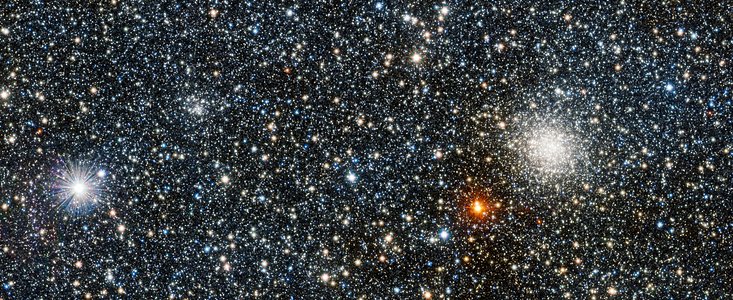Press Release
VISTA Finds New Globular Star Clusters
and sees right through the heart of the Milky Way
19 October 2011

Two newly discovered globular clusters have been added to the total of just 158 known globular clusters in our Milky Way. They were found in new images from ESO’s VISTA survey telescope as part of the Via Lactea (VVV) survey. This survey has also turned up the first star cluster that is far beyond the centre of the Milky Way and whose light has had to travel right through the dust and gas in the heart of our galaxy to get to us.
The dazzling globular cluster called UKS 1 dominates the right-hand side of the first of the new infrared images from ESO’s VISTA survey telescope at the Paranal Observatory in Chile. But if you can drag your gaze away, there is a surprise lurking in this very rich star field — a fainter globular cluster that was discovered in the data from one of VISTA’s surveys. You will have to look closely to see the other star cluster, which is called VVV CL001: it is a small collection of stars in the left half of the image.
But VVV CL001 is just the first of VISTA’s globular discoveries. The same team has found a second object, dubbed VVV CL002, which appears in image b [1]. This small and faint grouping may also be the globular cluster that is the closest known to the centre of the Milky Way. The discovery of a new globular cluster in our Milky Way is very rare. The last one was discovered in 2010, and only 158 globular clusters were known in our galaxy before the new discoveries.
These new clusters are early discoveries from the VISTA Variables in the Via Lactea (VVV) survey that is systematically studying the central parts of the Milky Way in infrared light. The VVV team is led by Dante Minniti (Pontificia Universidad Católica de Chile) and Philip Lucas (Centre for Astrophysics Research, University of Hertfordshire, UK).
As well as globular clusters, VISTA is finding many open, or galactic clusters, which generally contain fewer, younger, stars than globular clusters and are far more common (eso1128). Another newly announced cluster, VVV CL003, seems to be an open cluster that lies in the direction of the heart of the Milky Way, but much further away, about 15 000 light-years beyond the centre. This is the first such cluster to be discovered on the far side of the Milky Way.
Given the faintness of the newly found clusters, it is no wonder that they have remained hidden for so long; up until a few years ago, UKS 1 (seen in image a), which easily outshines the newcomers, was actually the dimmest known globular cluster in the Milky Way. Because of the absorption and reddening of starlight by interstellar dust, these objects can only be seen in infrared light and VISTA, the world’s largest survey telescope, is ideally suited to searching for new clusters hidden behind dust in the central parts of the Milky Way [2].
One intriguing possibility is that VVV CL001 is gravitationally bound to UKS 1 — making these two stellar groups the Milky Way’s first binary globular cluster pair. But this could just be a line-of-sight effect with the clusters actually separated by a vast distance.
These VISTA pictures were created from images taken though near-infrared filters J (shown in blue), H (shown in green), and Ks (shown in red). The size of the images show only a small fraction of the full VISTA field of view.
Notes
[1] The discovery of the additional new clusters was just announced in San Juan, Argentina, during the first bi-national meeting of the Argentinian and Chilean astronomical associations.
VVV CL001 was also noted independently on near-infrared images taken by amateur astronomer Steve Crouch of Canberra, Australia using a 31.75-cm telescope along with a CCD camera. Steve's image is available here: http://members.pcug.org.au/~stevec/uks1_STL6303_RC_IR_LRGB.jpg.
[2] The tiny dust grains that form huge clouds within galaxies scatter blue light much more strongly than red and infrared light. As a result astronomers can see through the dust much more effectively if they study infrared light rather than the usual visible radiation that our eyes are sensitive to.
More information
ESO, the European Southern Observatory, is the foremost intergovernmental astronomy organisation in Europe and the world’s most productive astronomical observatory. It is supported by 15 countries: Austria, Belgium, Brazil, Czechia, Denmark, France, Finland, Germany, Italy, the Netherlands, Portugal, Spain, Sweden, Switzerland and the United Kingdom. ESO carries out an ambitious programme focused on the design, construction and operation of powerful ground-based observing facilities enabling astronomers to make important scientific discoveries. ESO also plays a leading role in promoting and organising cooperation in astronomical research. ESO operates three unique world-class observing sites in Chile: La Silla, Paranal and Chajnantor. At Paranal, ESO operates the Very Large Telescope, the world’s most advanced visible-light astronomical observatory and two survey telescopes. VISTA works in the infrared and is the world’s largest survey telescope and the VLT Survey Telescope is the largest telescope designed to exclusively survey the skies in visible light. ESO is the European partner of a revolutionary astronomical telescope ALMA, the largest astronomical project in existence. ESO is currently planning a 40-metre-class European Extremely Large optical/near-infrared Telescope, the E-ELT, which will become “the world’s biggest eye on the sky”.
Links
- Associated research papers: A&A papers (Minniti et al A&A, 527, 81 & Moni Bidin et al. astro-ph:1109.1854)
- Photos of VISTA
Contacts
Dante Minniti
Pontificia Universidad Católica de Chile
Santiago, Chile
Tel: +56 2 463 3267
Email: dante@astro.puc.cl
Maren Hempel
Pontificia Universidad Católica de Chile
Santiago, Chile
Tel: +56 2 354 4945
Email: mhempel@astro.puc.cl
Christian Moni Bidin
Universidad de Concepción
Concepción, Chile
Tel: +56 9 9210 3235
Email: cmbidin@astro-udec.cl
Richard Hook
ESO, La Silla, Paranal, E-ELT and Survey Telescopes Public Information Officer
Garching bei München, Germany
Tel: +49 89 3200 6655
Cell: +49 151 1537 3591
Email: rhook@eso.org
About the Release
| Release No.: | eso1141 |
| Name: | VVV CL001, VVV CL002, VVV CL003, VVV Survey |
| Type: | Milky Way : Star : Grouping : Cluster : Globular |
| Facility: | Visible and Infrared Survey Telescope for Astronomy |
| Instruments: | VIRCAM |
| Science data: | 2011A&A...535A..33M 2011A&A...527A..81M |
Our use of Cookies
We use cookies that are essential for accessing our websites and using our services. We also use cookies to analyse, measure and improve our websites’ performance, to enable content sharing via social media and to display media content hosted on third-party platforms.
ESO Cookies Policy
The European Organisation for Astronomical Research in the Southern Hemisphere (ESO) is the pre-eminent intergovernmental science and technology organisation in astronomy. It carries out an ambitious programme focused on the design, construction and operation of powerful ground-based observing facilities for astronomy.
This Cookies Policy is intended to provide clarity by outlining the cookies used on the ESO public websites, their functions, the options you have for controlling them, and the ways you can contact us for additional details.
What are cookies?
Cookies are small pieces of data stored on your device by websites you visit. They serve various purposes, such as remembering login credentials and preferences and enhance your browsing experience.
Categories of cookies we use
Essential cookies (always active): These cookies are strictly necessary for the proper functioning of our website. Without these cookies, the website cannot operate correctly, and certain services, such as logging in or accessing secure areas, may not be available; because they are essential for the website’s operation, they cannot be disabled.
Functional Cookies: These cookies enhance your browsing experience by enabling additional features and personalization, such as remembering your preferences and settings. While not strictly necessary for the website to function, they improve usability and convenience; these cookies are only placed if you provide your consent.
Analytics cookies: These cookies collect information about how visitors interact with our website, such as which pages are visited most often and how users navigate the site. This data helps us improve website performance, optimize content, and enhance the user experience; these cookies are only placed if you provide your consent. We use the following analytics cookies.
Matomo Cookies:
This website uses Matomo (formerly Piwik), an open source software which enables the statistical analysis of website visits. Matomo uses cookies (text files) which are saved on your computer and which allow us to analyze how you use our website. The website user information generated by the cookies will only be saved on the servers of our IT Department. We use this information to analyze www.eso.org visits and to prepare reports on website activities. These data will not be disclosed to third parties.
On behalf of ESO, Matomo will use this information for the purpose of evaluating your use of the website, compiling reports on website activity and providing other services relating to website activity and internet usage.
Matomo cookies settings:
Additional Third-party cookies on ESO websites: some of our pages display content from external providers, e.g. YouTube.
Such third-party services are outside of ESO control and may, at any time, change their terms of service, use of cookies, etc.
YouTube: Some videos on the ESO website are embedded from ESO’s official YouTube channel. We have enabled YouTube’s privacy-enhanced mode, meaning that no cookies are set unless the user actively clicks on the video to play it. Additionally, in this mode, YouTube does not store any personally identifiable cookie data for embedded video playbacks. For more details, please refer to YouTube’s embedding videos information page.
Cookies can also be classified based on the following elements.
Regarding the domain, there are:
- First-party cookies, set by the website you are currently visiting. They are stored by the same domain that you are browsing and are used to enhance your experience on that site;
- Third-party cookies, set by a domain other than the one you are currently visiting.
As for their duration, cookies can be:
- Browser-session cookies, which are deleted when the user closes the browser;
- Stored cookies, which stay on the user's device for a predetermined period of time.
How to manage cookies
Cookie settings: You can modify your cookie choices for the ESO webpages at any time by clicking on the link Cookie settings at the bottom of any page.
In your browser: If you wish to delete cookies or instruct your browser to delete or block cookies by default, please visit the help pages of your browser:
Please be aware that if you delete or decline cookies, certain functionalities of our website may be not be available and your browsing experience may be affected.
You can set most browsers to prevent any cookies being placed on your device, but you may then have to manually adjust some preferences every time you visit a site/page. And some services and functionalities may not work properly at all (e.g. profile logging-in, shop check out).
Updates to the ESO Cookies Policy
The ESO Cookies Policy may be subject to future updates, which will be made available on this page.
Additional information
For any queries related to cookies, please contact: pdprATesoDOTorg.
As ESO public webpages are managed by our Department of Communication, your questions will be dealt with the support of the said Department.







